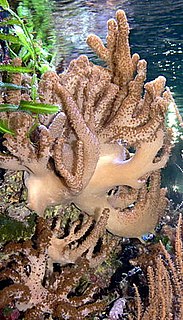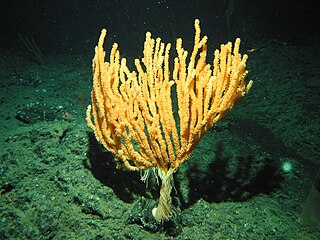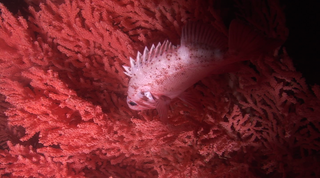| Primnoeides | |
|---|---|
| Scientific classification | |
| Kingdom: | Animalia |
| Phylum: | Cnidaria |
| Class: | Anthozoa |
| Order: | Alcyonacea |
| Family: | Primnoidae |
| Genus: | Primnoeides Studer & Wright, 1887 [1] |
Primnoeides is a genus of Cnidaria in the family Primnoidae.
| Primnoeides | |
|---|---|
| Scientific classification | |
| Kingdom: | Animalia |
| Phylum: | Cnidaria |
| Class: | Anthozoa |
| Order: | Alcyonacea |
| Family: | Primnoidae |
| Genus: | Primnoeides Studer & Wright, 1887 [1] |
Primnoeides is a genus of Cnidaria in the family Primnoidae.

The Challenger expedition of 1872–1876 was a scientific program that made many discoveries to lay the foundation of oceanography. The expedition was named after the naval vessel that undertook the trip, HMS Challenger.

Anthozoa is a class of marine invertebrates which includes the sea anemones, stony corals and soft corals. Adult anthozoans are almost all attached to the seabed, while their larvae can disperse as part of the plankton. The basic unit of the adult is the polyp; this consists of a cylindrical column topped by a disc with a central mouth surrounded by tentacles. Sea anemones are mostly solitary, but the majority of corals are colonial, being formed by the budding of new polyps from an original, founding individual. Colonies are strengthened by calcium carbonate and other materials and take various massive, plate-like, bushy or leafy forms.

HMS Challenger was a steam-assisted Royal Navy Pearl-class corvette launched on 13 February 1858 at the Woolwich Dockyard. She was the flagship of the Australia Station between 1866 and 1870.

Globigerina is a genus of planktonic Foraminifera, in the order of Rotaliida. It has populated the world's oceans since the Middle Jurassic.

Alcyonacea, or soft corals, are an order of corals. In addition to the fleshy soft corals, the order Alcyonacea now contains all species previously known as "gorgonian corals", that produce a more or less hard skeleton, though quite different from "true" corals (Scleractinia). These can be found in suborders Holaxonia, Scleraxonia, and Stolonifera. They are sessile colonial cnidarians that are found throughout the oceans of the world, especially in the deep sea, polar waters, tropics and subtropics. Common names for subsets of this order are sea fans and sea whips; others are similar to the sea pens of related order Pennatulacea. Individual tiny polyps form colonies that are normally erect, flattened, branching, and reminiscent of a fan. Others may be whiplike, bushy, or even encrusting. A colony can be several feet high and across, but only a few inches thick. They may be brightly coloured, often purple, red, or yellow. Photosynthetic gorgonians can be successfully kept in captive aquaria.
Janolus is a genus of small to large sea slugs, or more accurately nudibranchs, marine gastropod mollusks, in the family Proctonotidae. The name Janolus is derived from the two-headed god Janus, in ancient Roman mythology.
Cotula moseleyi, also known as Nightingale brassbuttons, is a species of flowering plant in the sunflower family. It has been found only in the Tristan da Cunha chain of islands in the South Atlantic Ocean. Its natural habitats are subantarctic forests, subantarctic grassland, rocky shores, and hillsides. It is threatened by habitat loss.

Thomas Henry Tizard was an English oceanographer, hydrographic surveyor, and navigator.

Bamboo coral, family Isididae, is a family of mostly deep-sea coral of the phylum Cnidaria. It is a commonly recognized inhabitant of the deep sea, due to the clearly articulated skeletons of the species. Deep water coral species such as this are especially affected by the practice of bottom trawling. These organisms may be an important environmental indicator in the study of long term climate change, as some specimens of bamboo coral have been discovered that are 4,000 years old.
Leucosyrinx bolbodes is a species of sea snail, a marine gastropod mollusk in the family Pseudomelatomidae, the turrids and allies.

Primnoa(Lamororux, 1812) also known as red tree coral, is a genus of soft corals and the type genus of the family Primnoidae (Milne Edwards, 1857). They are sessile, benthic cnidarians that can be found in the North Pacific, North Atlantic, and Subantarctic South Pacific, and its members often play a vital ecological role as keystone species within their environment as a habitat and refuge for the megafauna that also inhabit those regions. This, in combination with their slow growth, makes the increasing disturbance to their habitats caused by fishing activities particularly impactful and difficult to recover from.

Primnoa pacifica or red tree coral is a species of soft coral in the family Primnoidae. It is a deep water coral found in the North Pacific Ocean, and plays an integral role in supporting benthic ecosystems. Red tree corals grow axially and radially, producing structures of calcite and gorgonian skeletons that form dense thickets. Like other species of coral, red tree coral is made of a soluble form of calcium carbonate, which forms the reef structure, as well as provides food, shelter, and nutrients for surrounding organisms. Amongst the organisms red tree corals provide a home for, many are commercially important fish and crustaceans. These areas of marine habitat are listed as Habitat Areas of Particular Concern. However, anthropogenic impacts such as bottom trawling pose large-scale threats to these habitats. There are also concerns about the effects of ocean acidification on red tree coral, since it shares many of the same properties as other corals that are suffering from bleaching.

John Robertson Henderson CIE FRSE FZS FLS was a Scottish zoologist who specialized in the taxonomy of marine crustaceans, particularly the decapods, and worked on specimens collected by the oceanic research vessels Investigator and Challenger. From 1892 until 1911 he was Professor of Zoology at Madras Christian College in India. From 1908 to 1920 he was Superintendent of the Government Museum in Madras. He also took an interest in numismatics and Indian history.

Bathyphysa conifera, sometimes called the flying spaghetti monster, is a bathypelagic species of siphonophore in the family Rhizophysidae.
Poa novarae is a species of flowering plant in the family Poaceae (grasses), native to Saint Paul Island. It was first described by Heinrich Wilhelm Reichardt in 1871.
Eilhardia is a genus of calcareous sponges in the family Baeriidae. It contains one species, Eilhardia schulzei.
Stachyptilum is a genus in the family Stachyptilidae. The genus contains bioluminescent species.

Umbellula is a genus of cnidarians in the monotypic family Umbellulidae. The genus contains bioluminescent species.
Polyeunoa is a genus of marine annelids in the family Polynoidae. The genus contains two species, one from the Indian Ocean and the other widespread in the south-west Atlantic ocean and the Southern Ocean.

Benthodytes is a genus of sea cucumbers in the family Psychropotidae.